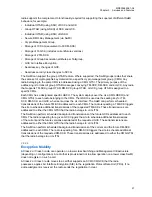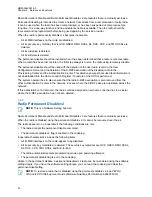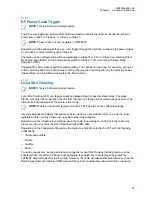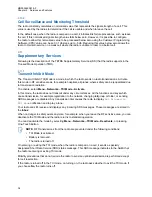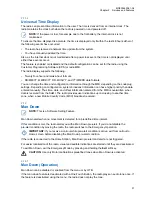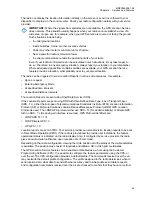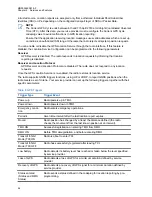
2.10.3
Multi-System Operation
The radio holds a list of up to 100 allowed network identities – Mobile Country Code (MCC) and Mobile
Network Code (MNC) combinations, that are considered friendly networks. The first network in this list
must be the radio home network.
Each network can have an associated name that can indicate to the user which network it is. The
radio can perform initial cell selection and registration on these networks. Registration on any of these
networks is performed using the radio Individual Short Subscriber Identity (ISSI) and without migration
signaling. The same ISSI is used on all networks. You can limit registration to the home network only,
or to a selected network only, and to ignore the other allowed networks.
In case the Base Transceiver Station (BTS) does not support the migration defined by ETSI standard,
multi-system operation is only supported as follows:
You can change the network mode using the MMI. A top-level menu item called
Networks Sel
allows
choosing between
Home Only
,
Select Net
, and
Any Net
. If the radio chooses a network different
from the current one, the radio forces initial cell selection to find a cell that belongs to the home or
the selected network. In the selected network option, a list of network names, where each network
name corresponds to one of the MNIs in the list, is displayed. The network names are provisioned in
the radio as part of provisioning of the MNI list. The network alias or MNI of the current network is
displayed on the first line of the idle display.
Home Only
In this mode the radio recognizes only the first system in the allowed list. As a result, the radio
registers only on its home network, even if a foreign network is in range and is found first.
Select Network (Select Net)
In this mode the radio recognizes only the system you selected in the list of allowed systems. As
the result, the radio registers only on this selected network, even if another network is in range and
is found first.
Any Network (Any Net)
In this mode radio selects the network automatically where the home network is not available.
The radio registers to any network that it finds that is already programmed into its codeplug list of
networks, whereby no user manual selection is required. Network selection to another network is
only performed at initial cell selection following a link fail and then only if the home network is not
available. The radio uses its own ISSI.
The radio operates in all networks as it does in its home network. All communications are placed using
SSI addresses, and it is the SwMI responsibility to reject communications for subscribers or groups
that cannot be reached in the local system.
NOTE:
The telephony gateway interprets telephone numbers with the country code of the local
country. For example, if you dial the number 01256-48-4566 in the UK, it is treated as if you
44-1256-48-4566.
For description of other BTS supported migrating modes used, refer to Air Interface Migration and
Dynamic Air Interface Migration sections.
2.10.4
Registration
On camping on a cell, the radio sends a registration request PDU to the SwMI, which includes a
request to attach to the selected talkgroup.
If the registration and attachment succeed, the radio begins normal operation on the cell. If the
registration attempt times out, or the SwMI rejects the registration for a temporary reason, another
registration attempt is made. If both attempts fail, the radio attempts to camp on a different cell.
MN003465A01-AF
Chapter 2 : Services and Features
33









